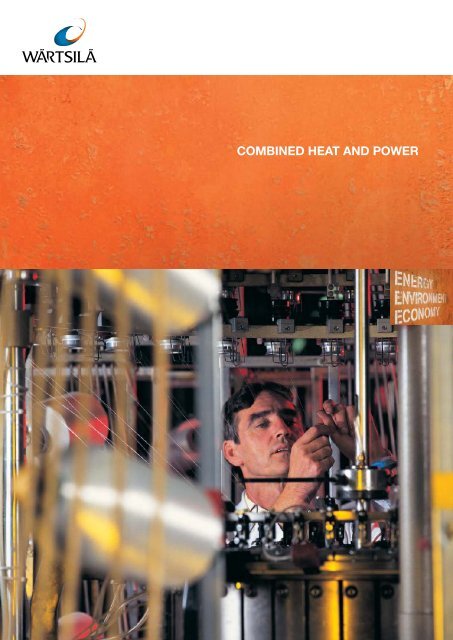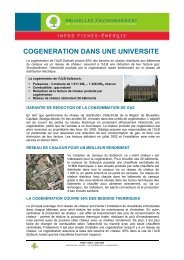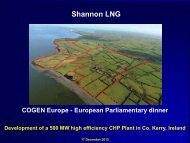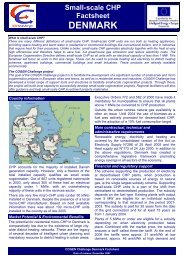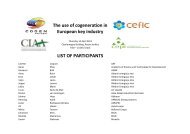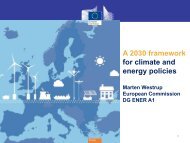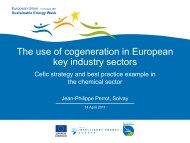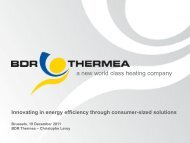COMBINED HEAT AND POWER - COGEN Europe
COMBINED HEAT AND POWER - COGEN Europe
COMBINED HEAT AND POWER - COGEN Europe
You also want an ePaper? Increase the reach of your titles
YUMPU automatically turns print PDFs into web optimized ePapers that Google loves.
capacity or temperature in the industrialprocess or the district heating network. Sucha plant is very suitable when all the heat andpower it produces can be used for either heator processing purposes.To optimize the balance between thermaland electrical energy production, each plant iscustomized to suit the needs of the end user.Whether it is hot water for district heating,industrial process steam or even chilledwater, Wärtsilä provides a design that ensuresmaximum efficiency and the best possibleoverall solution. The automation system notonly controls all the internal processes inthe Wärtsilä CHP plant but is also carefullyintegrated with all necessary signals andconnections to existing systems to guarantee afully compatible plant.<strong>POWER</strong>FUL CHOICESThe high efficiency of Wärtsilä’s CHP plantstranslates into considerable savings in fuelcosts compared to other technologies. Foroptimized balance and profitability, theplants are customized to the customer’sspecific needs.A decentralized combined heat andpower plant increases the reliability ofenergy supply in the neighbourhood. Totalenergy production is local and close to thepoint of consumption. Local heat generationensures a quick response to changes inLOW-PRESSURE STEAM GENERATION FOR INDUSTRIAL APPLICATIONSElectricitySteam generatorLube oil coolerCAC 1 and 2SteamconsumerHot waterconsumer(optional)<strong>COGEN</strong> FOR MAXIMUM STEAM GENERATIONSteamconsumerElectricityBurnerCAC 1 and 26
8RINGKØBING, DENMARK:Type of customer ......................................UtilityEngine type ...................... 1 x Wärtsilä 20V34SGTotal electrical output............................ 7.9 MWTotal heat output ................................... 9.7 MWTotal effi ciency ........................................... 96%Fuel .............................................................Gas
GasLiquid fuelGas fuelGas fuelLiquid fuelLiquidfuelGasSG operationDual-fuel operationGD operationDiesel operationENGINE WORKING PRINCIPLESDerating factor1.0510.950.90.85Derating due to cooling water temperature.(Derating due to inlet air temperature starts at 45°C)Wärtsilä 20V34SG(radiator cooling)Industrial gas turbineAeroderivate gas turbine0.815 20 25 30 35 40 45Ambient temperature (°C)Source: GE Ger-3567 Ger-3695; Wärtsilä perfWärtsilä reciprocating gas engines offer stable outputand high performance in hot and dry conditions. No waterconsumed for plant cooling = remote area suitability!ENGINE TECHNOLOGYA+reciprocating+engine+is+the+most+effi+cient+means+of+converting+liquid+or+gaseous+fuels+into+energy.The+Wärtsilä+CHP+plant+can+run+on+most+natural+gas+types,+heavy+and+light+fuel+oils,+and+emulsifi+ed+fuels.+Dual-fuel+engines+give+added+reliability+to+the+CHP+plant,+since+they+can+use+whichever+fuel+is+available+at+the+lowest+cost.The+heart+of+Wärtsilä’s+generating+sets+is+Wärtsilä’s+reliable+engine+technology,+the+result+of+long+experience+of+demanding+marine+and+power+plant+applications.+All+Wärtsilä+engines+have+a+simple+and+straightforward+modern+design+with+facilities+for+easy+and+rapid+on-site+maintenance.The Wärtsilä 20V34SG engine featuresthe latest design in gas technology.9
Typical interior and design of a control roomin Wärtsilä power plants.CUSTOMER CAREWärtsilä’s aim is to ensure that customersobtain the best possible performance fromtheir power plant investment throughout itslifecycle. After all, who could be better at thisthan the people who designed and built theplant?Wärtsilä provides a comprehensive rangeof services built on the concept of enhancingthe customer’s profitability by optimizing allaspects of the power plant operation.The services range from rapid spareparts delivery to a complete operation andmaintenance partnership, allowing thecustomer to focus on their core business.Wärtsilä Operations & Maintenance currentlyruns more than 130 plants around the world,making it the world’s leading power plant O&Mcontractor.If customers choose to operate the plantthemselves, they can still rest assured thatthey have the best possible support availableas and when needed – from training andon-line support to service packages or plantmodernization and upgrading. Wärtsilä’sglobal network is always ready to make surethe power plant performs flawlessly, freeof breakdowns and unwanted downtimethroughout its lifetime.10
<strong>COMBINED</strong> CYCLE SOLUTIONSWärtsilä’s combined cycle solutions withreciprocating engines reach plant efficienciesfar above 50%. This is achieved by recoveringenergy from the otherwise wasted heatproduced in thermal power plants, either byusing a conventional steam bottoming cyclerecovering hot exhaust gases or an organicrankine cycle recovering heat from sourceswith lower temperatures.Photo courtesy of Jung Bu City Gas and JB Enertek Co., LtdCHEONG SOO, KOREAThe purpose of Cheong Soo plant is to provide District heating andelectricity (CHP) to a newly established and build town with about6400 house holds including public buildings. The CHP plant generateselectricity in parallell with the electrical grid and supplies the districtheating to the network for the town. During summer the plant providesalso district cooling.Type of customer ............................................................................ IPPEngine type..........................................................2 x Wärtsilä 20V34SGTotal electricity output............................................................. 16.9 MWTotal heat output.................................................................... 14.2 MWTotal efficiency........................................................................... 85.1%Fuel.................................................................................... Natural gas11
THE SINGLE-SOURCESUPPLIER THATSTAYS WITH YOUWärtsilä has the resources and capabilitiesto carry out deliveries ranging from thesupply of equipment and basic engineering tocomplete turnkey projects including financing,engineering, procurement, construction,operation and maintenance.BARAJAS AIRPORT, SPAINIn 2003, AENA, the Spanish Airport Authority, called for bids to supplythermal and electrical energy to the major Barajas airport in Madrid undera twenty-year power purchase agreement.The trigeneration plant, generating a net electric power of 33 MW, isconnected to the airport’s internal grid and to the public grid. The plantprovides electricity continuously, as well as heating during the winter andcooling during the summer.Engines................................................................6 x Wärtsilä 18V32DFTotal electrical output.............................................................33.6 MW eTotal heat output..................................................................... 24 MW thTotal absorption cooling output..................................................18 MW cTotal efficiency.............................................................................. 74%Fuel............................................................................. Natural gas/LFOLINATE AIRPORT, MILAN, ITALYType:.......................................... Industrial self generation, TrigenerationEngines................................................................3 x Wärtsilä 20V34SGTotal electrical output................................................................24 MW eTotal heat output.................................................................. 17.5 MW thTotal efficiency.......................................................................... 80.2 %Fuel.................................................................................... Natural gas12
THIS IS NOT THE FUTURE.THIS IS TODAY.THE+WÄRTSILÄ+TOWN+CONCEPT+is+a+Combined+Heat+and+Power+plant+designed+for+decentralized+energy+production+in+built-up+areas+close+to+consumers.+These+facilities+have+a+high+level+of+performance,+comply+with+all+environmental+regulations+–+particularly+noise+emissions+–+and+are+designed+to+blend+smoothly+into+the+surrounding+urban+architecture.+As+the+heat+recovery+system+and+other+auxiliaries+are+built+into+functional+modules+surrounding+the+engine,+Town+Concept+plants+have+a+small+footprint.Town+Concept+CHP+plants+can+also+easily+be+expanded+as+the+demand+for+power+and+heat+grows.Exhaust stacksCooling radiatorsExhaust gas boilerTransformerControl roomLubricationoil tankEngine air intake fi ltersEngine generator setModule for hot water generationEngine exhaust outletDistrict heating pumpFeed and return for district13
<strong>POWER</strong> PLANT OUTPUT RANGEGas enginesWärtsilä 34SGMW 1 5 10 50 100 300 500Dual-fuel engines (gaseous fuel/liquid fuel)Wärtsilä 32GDWärtsilä 34DFWärtsilä 50DFLiquid fuel (LFO, HFO, CRO, emulsified, LBF)Wärtsilä 20Wärtsilä 32Wärtsilä 46LFO = light fuel oilHFO = heavy fuel oilCRO = crude oilLBF = liquid biofuelBoiler and absorption chillers atMadrid’s Barajas airport, Spain.14
Performance data as guidelines for CHP calculations – Wärtsilä gas fuelled generating sets at 50 and 60 HzPerformance dataWärtsilä gas enginesat frequency 50 HzWärtsilä gas enginesat frequency 60 HzEngine 9L34SG 16V34SG 20V34SG 20V34DF 18V50DF 9L34SG 16V34SG 20V34SG 20V34DF 18V50DFEngine optimization: +NO X (dry @ 15 vol-% O 2 )Gas +modemg/Nm 3 95–190* 95–190* 95–190* 190–380*Liquid +fuel+mode1460–2000* (LFO)+1600–2000 (HFO)Gas +modeLiquidfuel +modeGas +mode190–380* 2000* 95–190* 95–190* 95–190* 190–380*Liquid +fuel+mode1460–2000* (LFO)+1600–2000 (HFO)Gas +modeLiquid +fuel+mode190–380* 2000*Electric power kW 3888 6970 8730 8730 8730 16621 16621 3758 6737 8439 8439 8439 17076 17076Heat rate 1) kJ/kWh 7817 7753 7737 8036 8127 7616 8185 7817 7753 7737 8036 8127 7616 8186Efficiency 1) % 46.1 46.4 46.5 44.8 44.3 47.3 44.0 46.1 46.4 46.5 44.8 44.3 47.3 44.0Cooling circuit inlet/outlet 2) °C 36/59 36/66 36/67 36/69 36/77 36/68 42/83 36/58 36/65 36/66 36/68 36/75 36/68 42/85––HTCAC temperature inlet/outlet °C 42/52 45/57 46/58 47/59 49/65 45/59 54/72 42/52 45/56 45/57 46/58 48/64 45/59 55/73––Cylinder temperature inlet/outlet °C 84/91 82/91 82/91 81/91 83/91 80/85 79/85 84/91 83/91 82/91 81/91 83/91 80/85 78/85––Lubrication oil circuit inlet/outlet °C 63/74 63/76 63/77 63/78 63/80 63/74 63/78 63/74 63/76 63/76 63/78 63/79 63/74 63/78––LTCAC temperature inlet/outlet °C 36/37 36/38 36/39 36/39 36/41 36/38 42/46 36/37 36/38 36/38 36/39 36/40 36/38 42/46Charge air flow ± 5% kg/s 6.2 11.1 13.8 14.1 17.5 26.2 32.5 6.0 10.7 13.4 13.5 16.7 26.1 32.5Exhaust gas flow ± 5% kg/s 6.4 11.4 14.2 14.5 17.9 27.0 33.5 6.2 11.0 13.8 13.9 17.2 26.6 33.5Exhaust gas temp. ± 15 °C 400 400 400 380 335 400 377 400 400 400 380 335 401 369Exhaust gas energy ± 10% kW 2657 4733 5924 5714 5975 11016 12705 2567 4572 5722 5486 5718 11379 12415Cooling circuit-energy ± 10% kW 1929 3436 4294 4595 5631 7403 9504 1868 3322 4147 4432 5404 7409 9991––HTCAC energy ± 10% kW 840 1405 1723 1710 2238 3237 4129 817 1369 1680 1659 2168 3219 4117––Cylinder cooling energy ± 10% kW 560 1005 1254 1404 1587 2101 2514 540 965 1214 1354 1517 2238 2925––Lubrication oil energy ± 10% kW 424 761 961 1065 1149 1528 1967 414 741 920 1035 1108 1538 2048––LTCAC energy ± 10% kW 105 265 357 416 662 542 884 97 247 333 384 611 539 901Heat losses by radiation ± 20% kW 130 230 290 350 350 630 670 120 220 280 340 340 640 670Note: Heat and mass balances are dependent on ambient conditions and plant application, above given figuresare for guidance only and calculated at ISO 3046 reference conditions; 25°C ambient temperature, 100m abovesea level and 30% relative humidity.1) Heat rate and electrical efficiency at generator terminals, including engine-driven pumps, ISO 3046 conditionsand LHV. Tolerance 5%. Power factor 0.8. Gas Methane Number >802) Single-circuit cooling system.* Adjustable NO X range according to local requirements. Heat rates given at the marked NO X optimization level.Heat rates at other NO X optimization levels to be checked case by case.Note! 1 ppm-v dry @ 15% O 2 » 2.054 mg/Nm 3 dry @ 15% O 2 , NO X calculated as NO 2 , Nm 3 defined at NTP(273.15 K and 101.3 kPa).Performance data as guidelines for CHP calculations – Wärtsilä liquid fuelled generating sets at 50 and 60 HzPerformance dataWärtsilä diesel enginesat frequency 50 HzWärtsilä diesel enginesat frequency 60 HzEngine 9L20 12V32 16V32 18V32 20V32 18V46 9L20 12V32 16V32 18V32 20V32 18V46Engine optimization: +NO X (dry @ 15 vol-% O 2 )ppmvol710*-780 710*-970 710*-970 710*-970 710*-970 900*-970 710*-780 710*-970 710*-970 710*-970 710*-970 900*-970Electric power kW 1539 5327 7124 8032 8924 17076 1454 5211 6970 7841 8730 17076Heat rate 1) kJ/kWh 8604 7880 7856 7840 7840 7698 8561 7880 7856 7861 7840 7698Efficiency 1) % 41.8 45.7 45.8 45.9 45.9 46.8 42.0 45.7 45.8 45.8 45.9 46.8High temperature circuit inlet/outlet °C 84/91 79/96 80/96 80/96 80/96 80/91 84/91 80/96 80/96 80/96 80/96 80/91––HTCAC temperature inlet/outlet °C 87/96 87/96 88/96 87/96 83/91 87/96 87/96 88/96 88/96 83/91––Cylinder temperature inlet/outlet °C 84/91 79/87 80/87 80/88 80/87 80/83 84/91 80/87 80/87 80/88 80/88 80/83Low temperature circuit inlet/outlet °C 34/47 38/49 38/49 38/49 38/49 42/55 34/48 38/49 38/49 38/49 38/49 42/55––Lubrication oil circuit inlet/outlet °C 63/78 63/77 63/78 63/78 63/79 63/80 63/77 63/77 63/78 63/78 63/79 63/80––LTCAC temperature inlet/outlet °C 34/44 38/43 38/43 38/43 38/43 42/47 34/44 38/43 38/43 38/43 38/43 42/47Charge air flow ± 5% kg/s 3.5 10.2 13.6 15.3 17.0 31.6 3.3 9.7 13.0 14.6 16.2 31.6Exhaust gas flow ± 5% kg/s 3.6 10.5 14.0 15.7 17.5 32.5 3.4 10.0 13.3 15.0 16.7 32.7Exhaust gas temperature ± 15 °C 303 347 348 349 349 346 302 352 352 354 354 344Exhaust gas heat ± 10% kW 1052 3629 4849 5472 6082 11212 991 3515 4698 5306 5897 11222High temperature circuit-energy ± 10% kW 371 1891 2453 2726 3030 5135 345 1805 2427 2654 2949 5141––HTCAC energy ± 10% kW 1044 1319 1443 1604 3484 971 1309 1388 1543 3490––Cylinder cooling energy ± 10% kW 371 847 1134 1283 1426 1651 345 834 1118 1266 1407 1651Low temperature circuit-energy ± 10% kW 832 1246 1668 1885 2093 3750 776 1205 1623 1829 2032 3753––Lubrication oil energy ± 10% kW 246 657 877 988 1097 2249 221 646 862 972 1080 2249––LTCAC energy ± 10% kW 586 589 791 897 996 1501 556 559 761 857 951 1504Heat losses by radiation ± 20% kW 68 185 247 278 308 451 68 180 240 270 300 451Note: Heat and mass balances are dependent on ambient conditions and plant application, above given figuresare for guidance only and calculated at ISO 3046 reference conditions; 25°C ambient temperature, 100m abovesea level and 30% relative humidity.1) Electrical output at generator terminals, including engine-driven pumps at 100% load. ISO conditions and LHV(42700 kJ/kg). Tolerance 5 %. Power factor 0.8.* Adjustable NO X range according to local requirements. Heat rates given at the marked NO X optimization level. Heat ratesat other NO X optimization levels to be checked case by case.Note! 1 ppm-v dry @ 15% O 2 » 2.054 mg/Nm 3 dry @ 15% O 2 , NO X calculated as NO 2 , Nm 3 defined at NTP (273.15 Kand 101.3 kPa).15
Wärtsilä is a global leader in complete lifecycle power solutions for themarine and energy markets. By emphasising technological innovationand total efficiency, Wärtsilä maximises the environmental and economicperformance of the vessels and power plants of its customers.01.2010 / Bock´s Office / LitosetIn 2008, Wärtsilä’s net sales totalled EUR 4.6 billion with 19,000 employees.The company has operations in 160 locations in 70 countries around theworld. Wärtsilä is listed on the NASDAQ OMX Helsinki, Finland.WÄRTSILÄ ® is a registered trademark. Copyright © 2005 Wärtsilä Corporation.WÄRTSILÄ ® is a registered trademark. Copyright © 2010 Wärtsilä Corporation.


